We had to be at the bus stop at 7am, so we just ate protein bars in the room before boarding the bus for Pearl Harbor, where we spent most of our day. This ended up being kind of a theme of the day as we had nothing but snacks to eat until dinner in Waikiki later.
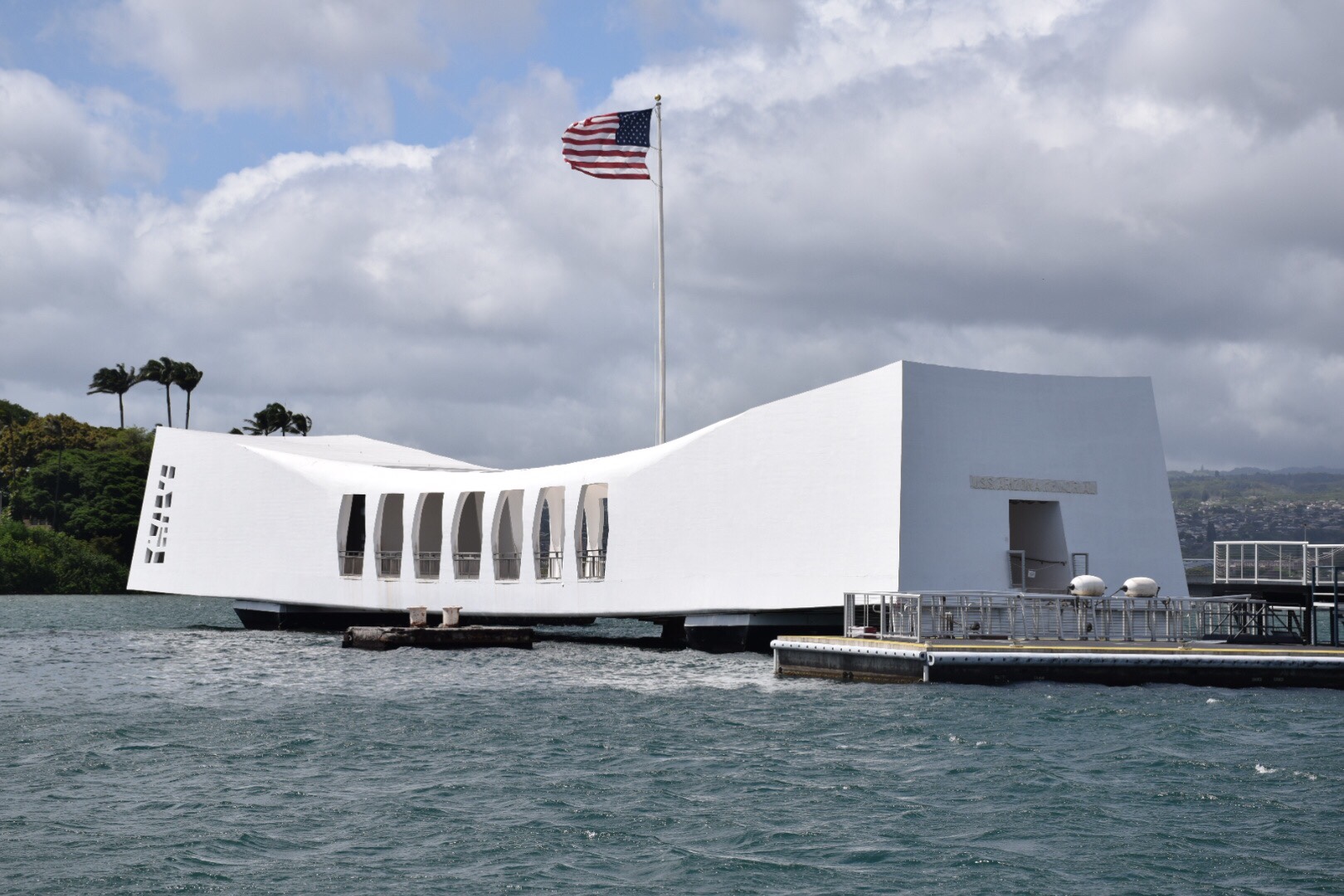
Our driver Kimoke’o told us a lot about the history of Pearl Harbor and the Japanese attack during our drive from Wikiki to the base. The Hawaiian name for Pearl Harbor is “Pu’uloa” which means “long hill.” It was named Pearl Harbor due to the presence of many pearled oysters in the waters. Kimoke’o told us that Hawaiians were more interested in the meat of the oyster than the pearl and would often toss the pearls back in the harbor. King David Kalakau gave the U.S. exclusive right to Pu’uloa in the late 1800s. The U.S. originally used the harbor for shipments of coal but eventually moved their largest fleet to Hawaii because it is a strategic location.
In the 1930s, the U.S. was neutral with regard to wars (including WWII), but provided fighter pilots to Britain and stopped shipments of oil to Japan. Japan needed to find new sources of oil and wanted to clear out the U.S. fleet from Pearl Harbor so they could get oil from other Pacific islands without interference from the U.S. fleet. This was part of the motivation for Japan’s attack on Pearl Harbor on Dec 7, 1941.
Kimoke’o told us that the sailors left open the roof hatches on the battleships due to heat in Hawaii and this ultimately hastened the sinking of the USS Arizona. A Japanese bomber dropped a torpedo that hit the Arizona’s ammunition magazine, causing an explosion (some say the explosion raised it off the water). The open hatches allowed it to sink within nine minutes due to loss of buoyancy. 1,177 sailors died with with the Arizona, which was almost half of casualties in the entire two-hour attack with approximately 350 aircraft.
The Japanese also hit five other airbases during the attack in addition to Pearl Harbor:
- Wheeler Field
- Ewa
- Kaneohe
- Bellows Field
- Hickman Field
This attack thrust America into WWII.
After clearing two security checkpoints entering the base, our first stop was the Battleship Missouri on Ford Island. On our way to the Missouri, we briefly got to see the memorial for the USS Oklahoma, which also sank during the Pearl Harbor attack and 429 sailors were lost.
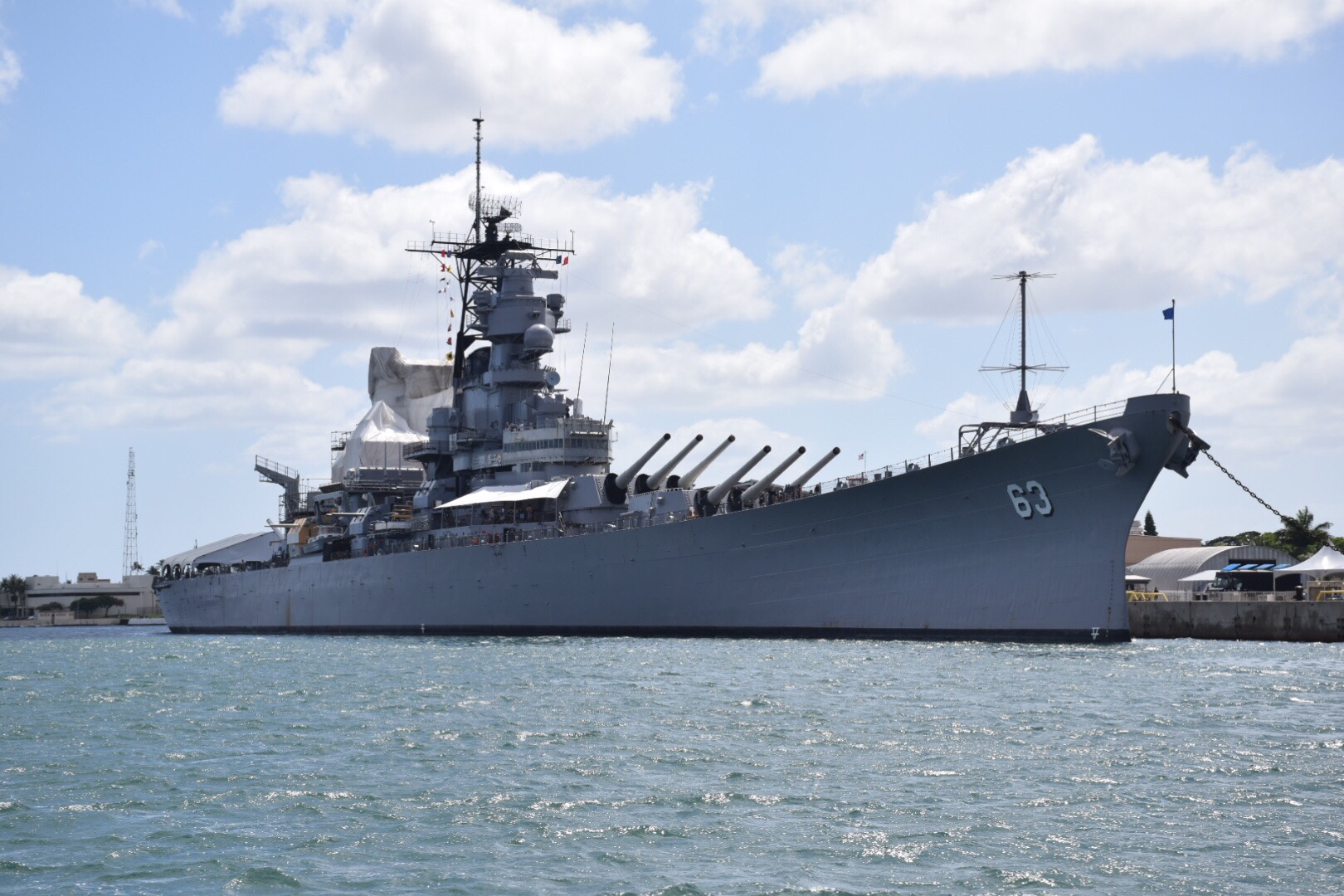
The Missouri was not part of the Pearl Harbor attack as it was under construction at the time and not completed until 1944. It was an Iowa Class battleship and was christened by the daughter of Harry Truman, who was the junior Senator from Missouri. Harry Truman was later President of the United States when the Missouri was used as the site where the Instruments of Surrender were signed to officially end WWII.
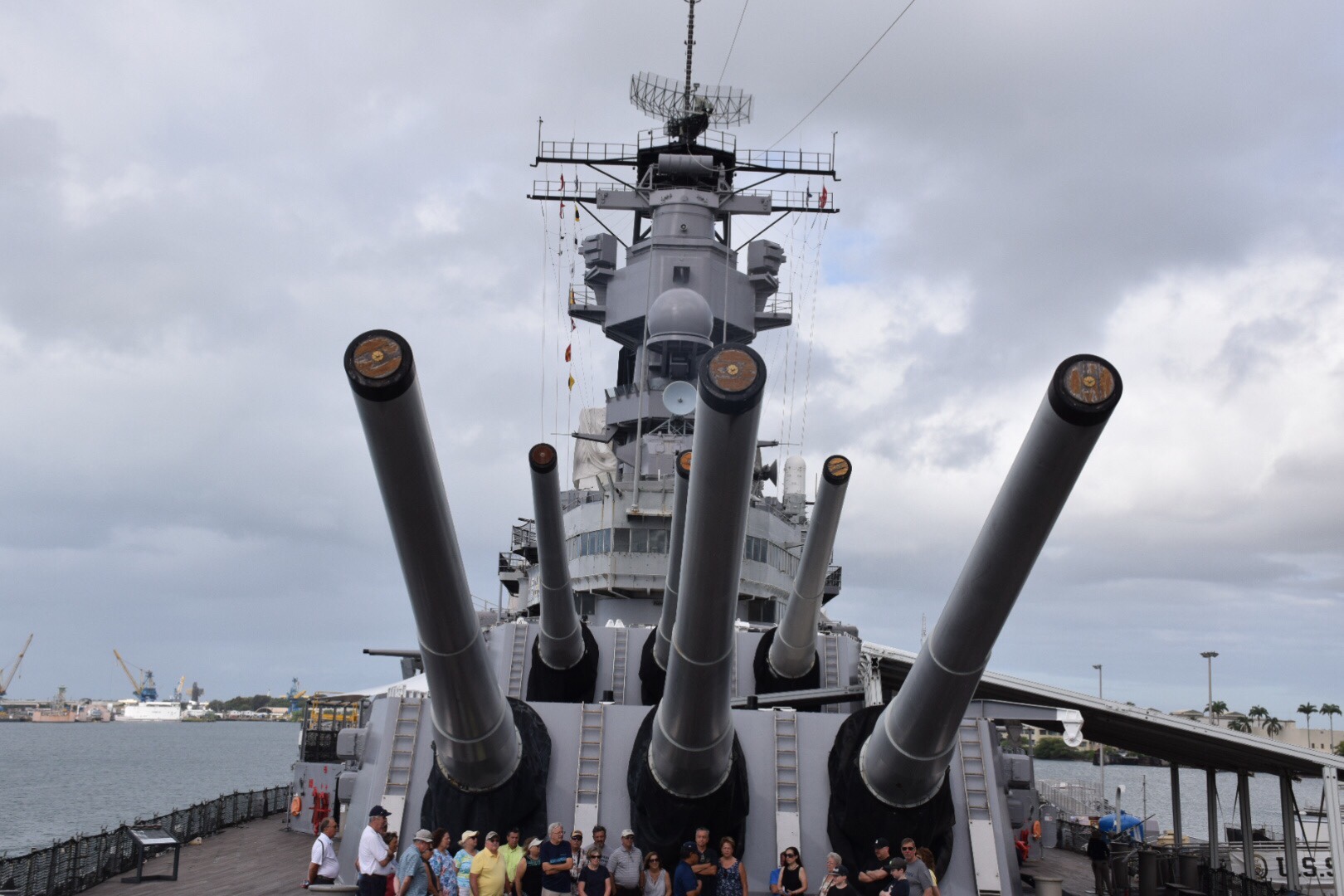
Onboard the Missouri, we had a guided group tour from Robert who took us up in front of the forward gun turret and gave us a LOT of information about the ship:
- Construction began on January 6, 1941 and was completed 0n January 29, 1944
- It was used as the location of the signing of the Instruments of Surrender on September 2, 1945
- It was used in the Korean War from 1950 to 1953 and then decommissioned for 29 years
- It was upgraded in the 1980s during the Presidency of Ronald Regan and was recommissioned on May 10, 1986
- It was used in the Persian Gulf War before being decommissioned in 1992.
- It opened for tours in Pearl Harbor in 1999
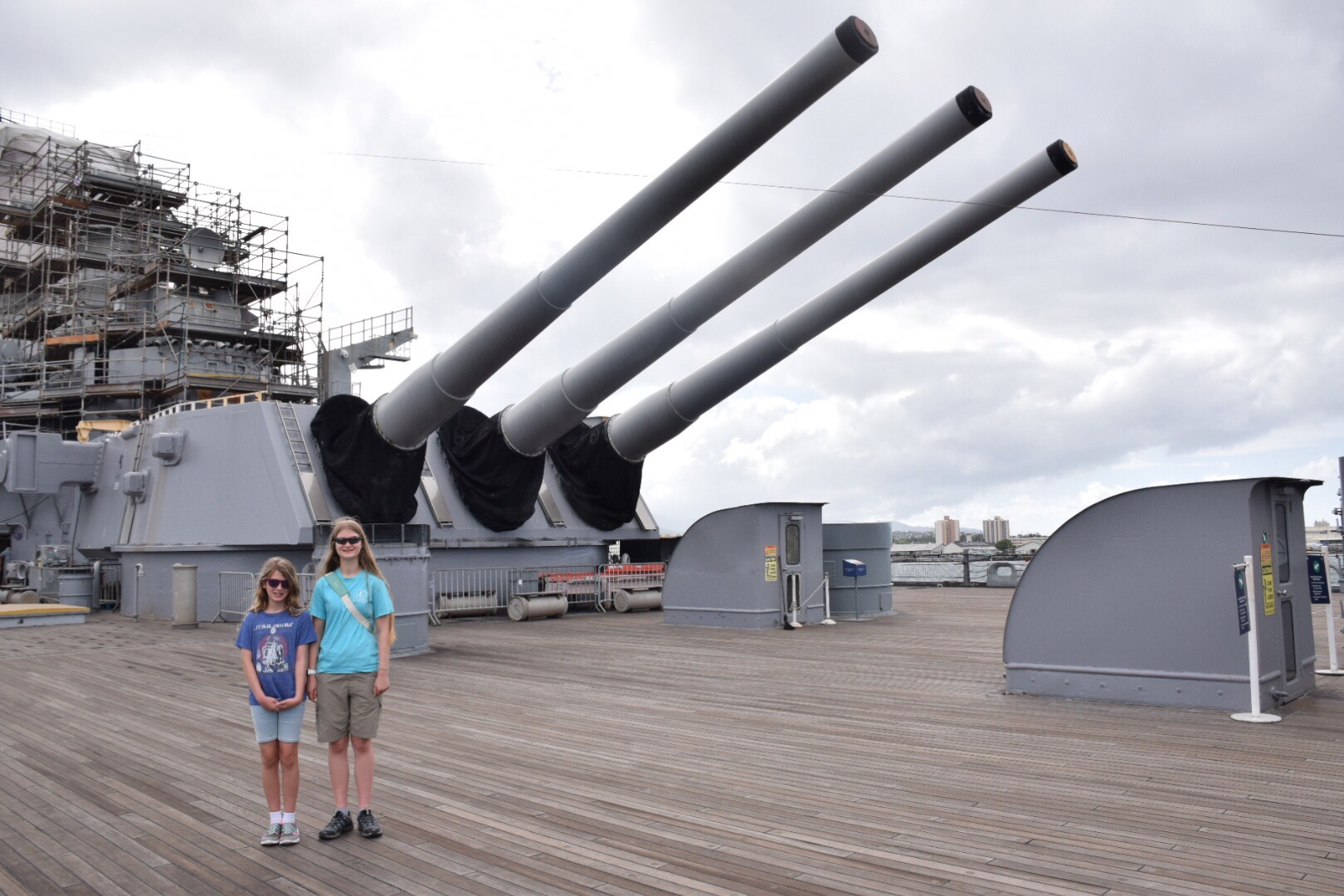
- It contains nine, 16-inch, 50 caliber guns on three turrets that fire accurately at mach 2 up to 23 nautical miles. They can fire armor piercing projectiles that weight 2700 lbs each and high capacity explosives that weight 1990 lbs each. Gunpowder bags weighed 110 lbs each, and it took six bags to fire a single shot.
- It is 887 feet long, 108 ft wide, 216 ft tall from keel to mast (20 stories), and weighs 58,000 metric tonnes. This was longer and skinnier than the Arizona. It was made skinnier to fit through the Panama Canal, which was 110 ft wide.
- It has a top speed of 33 knots (40 mph)
- It was used as the location of Cher’s music video for “If I Could Turn Back Time.”
- It was used in the movie “Under Siege” starring Steven Segal
- It has a top deck made of teak to allow for air circulation to lower decks since the ship does not have air conditioning.
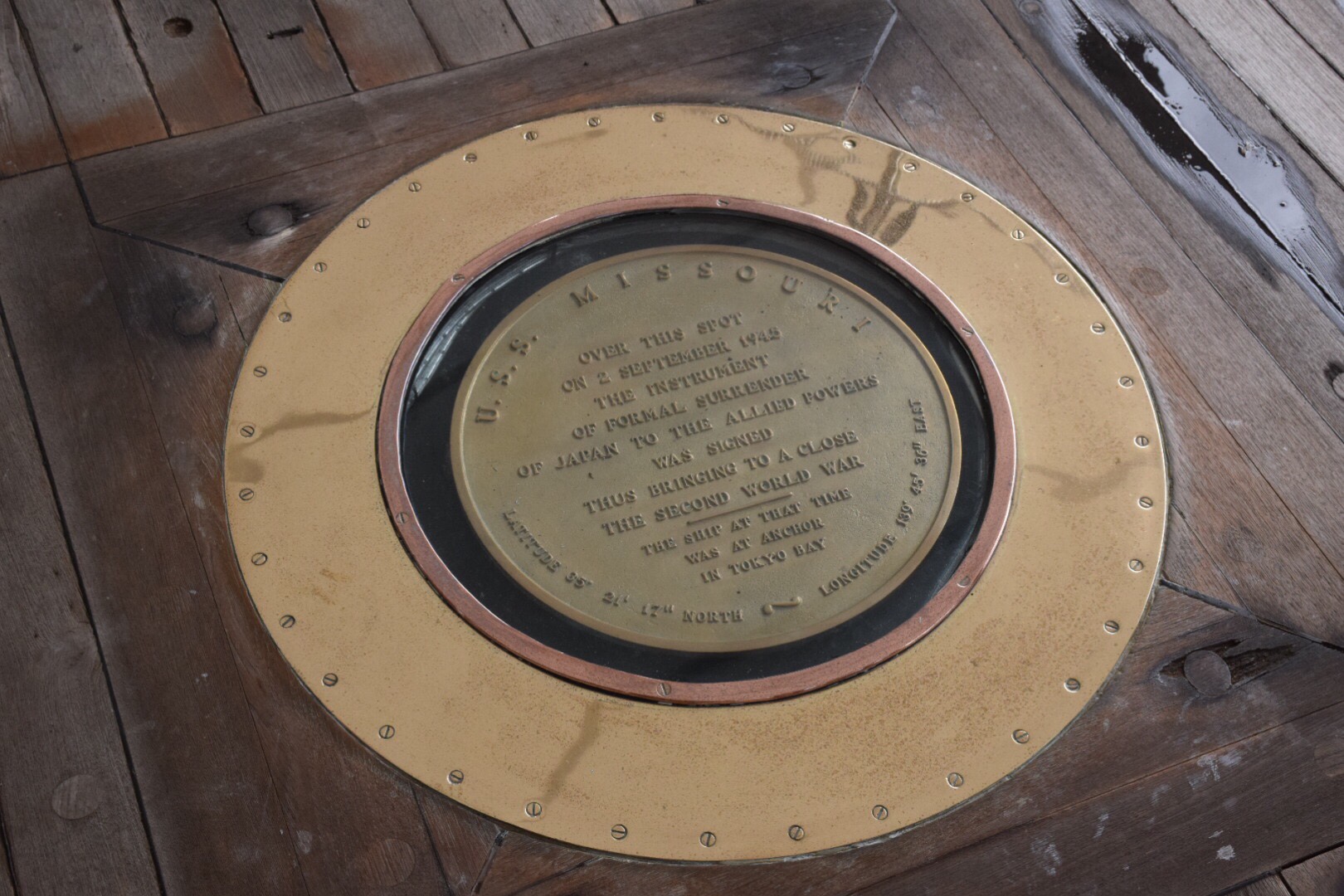
From the forward gun turrets, we went to the “Surrender Deck” and saw the spot where the Instruments of Surrender were signed after General McArthur opened the ceremony with a speech. Seeing this spot was overwhelming and definitely the highlight for me. We also saw a reproduction of the Instruments of Surrender, and it was somewhat humorous to find out that the Canadian representative had signed his name in the wrong spot. This is about the only humorous thing about a war that claimed at least 60 million lives. This is almost hard to comprehend.

Finally we went to the “Kamikaze Deck,” which was the site of a kamikaze attack. Robert asked if anyone knew the meaning of the world “kamikaze,” and Kate raised her hand and confidently answered “divine wind.” I had no idea this was the meaning, but was very proud of Kate. In the attack, the kamikaze pilot hit the side of ship and his bomb dropped harmlessly into the ocean. However one wing snapped off and started fire on deck, but the sailors put it out in 3 minutes. The only casualty was the kamikaze pilot who had been thrown onto the deck during the crash. Captain Callahan of the Missouri insisted that the 19-year-old pilot be given a military burial at sea with a makeshift Japanese flag. On the deck, they had a picture of the attack and crash, which was remarkable.
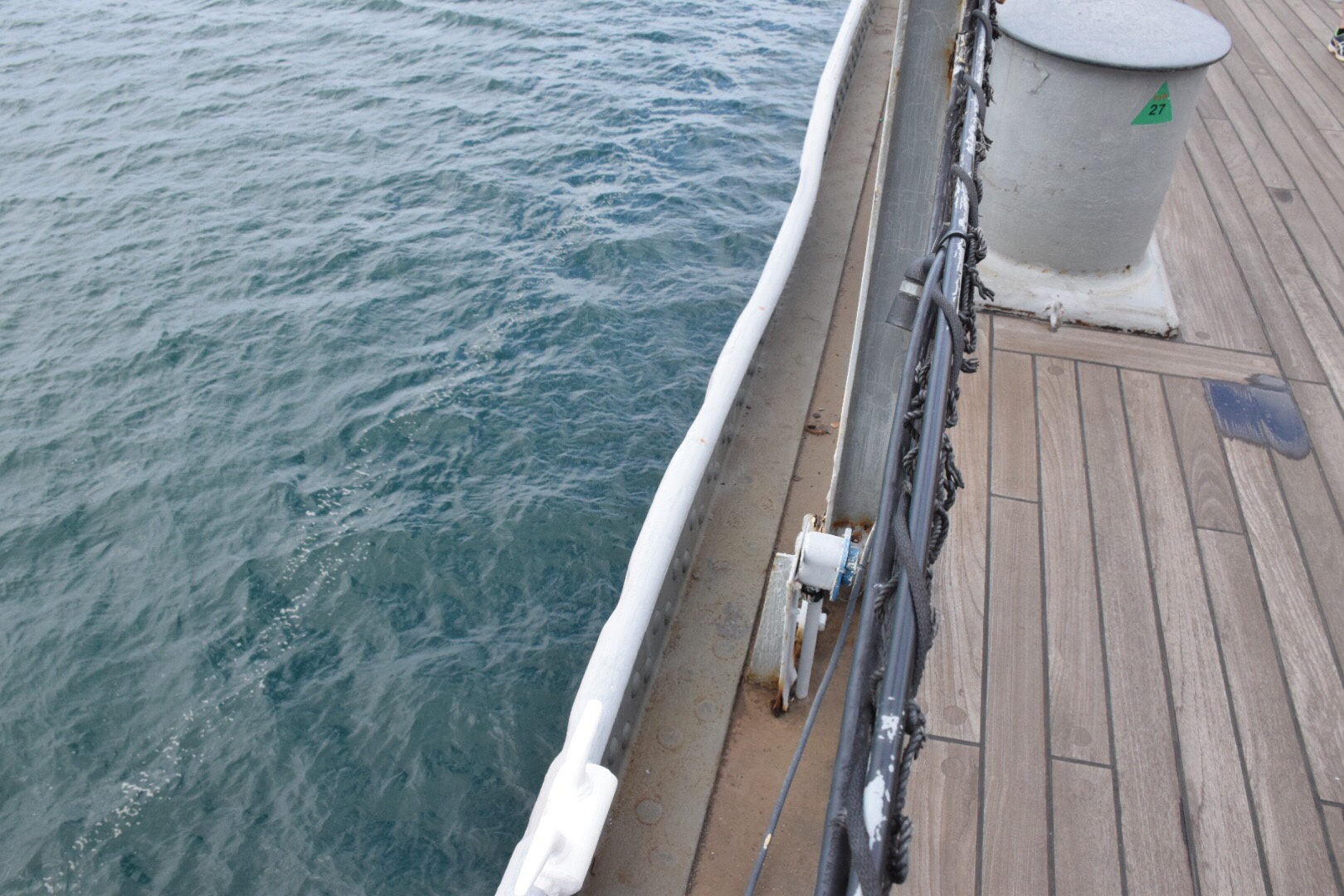
You can also still see the dent in the side of the ship from the impact.
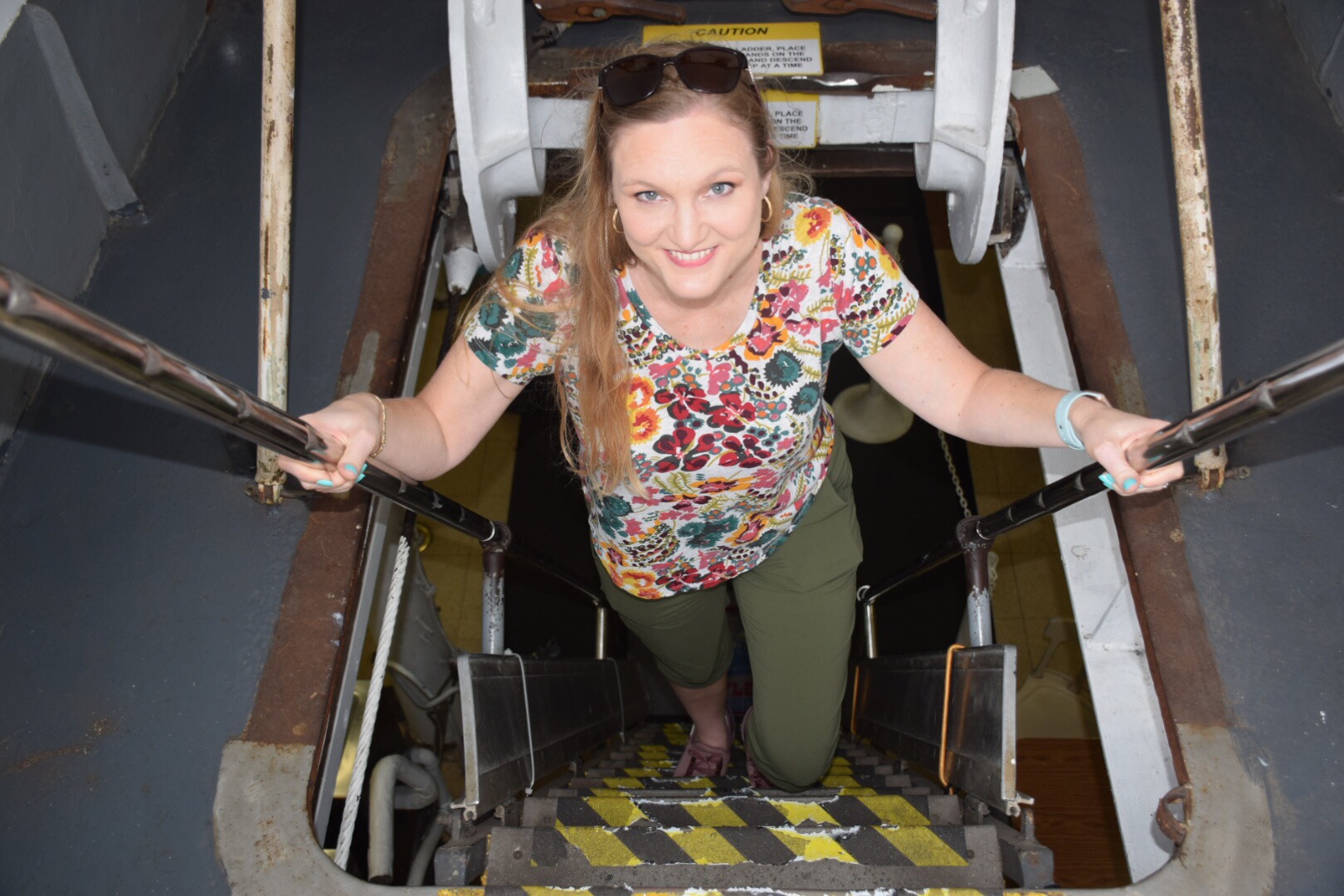
After leaving our guide Robert, we continued to explore the lower decks and saw mess halls, sleeping quarters, offices, and many other facilities aboard the Missouri. Most of the sleeping quarters were just racks and racks of bunks, but the quarters for the executive officer looked like a hotel room.
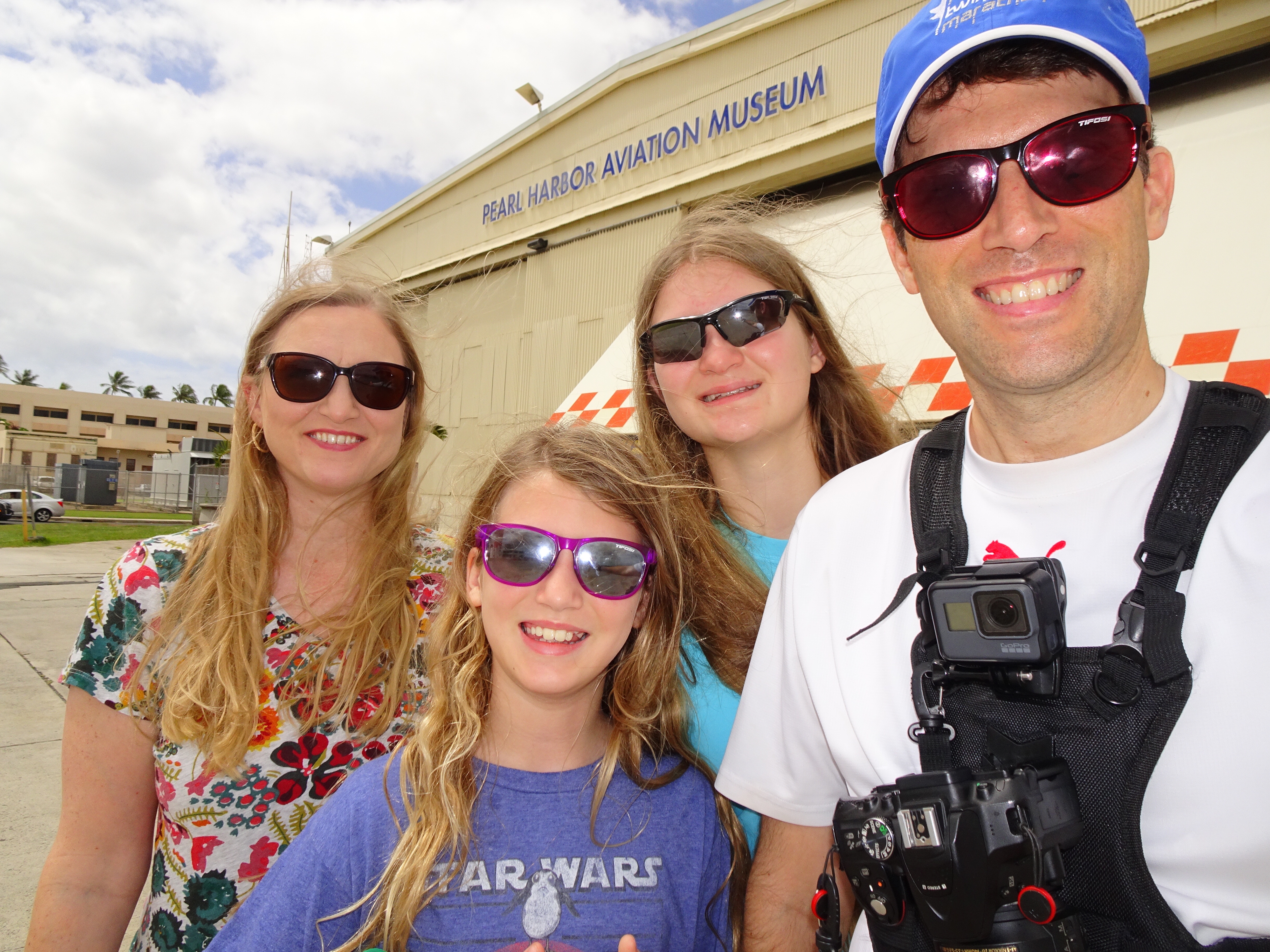
Upon leaving the USS Missouri, we then went to the Pearl Harbor Aviation Museum. It is made up of two original hangars:
- Hangar 39 – Pearl Harbor era planes
- Hanger 79 – More modern planes
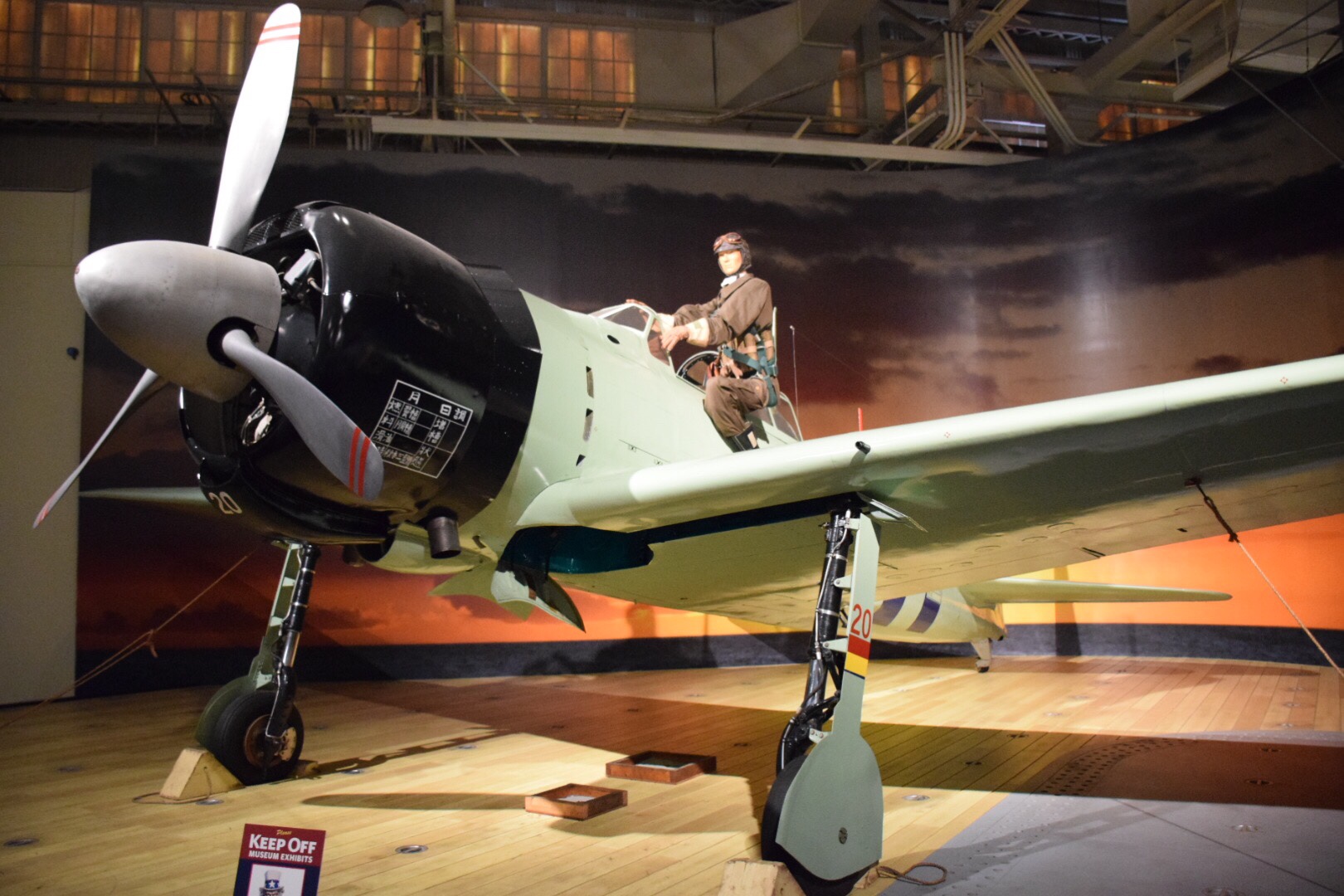
The highlight of Hangar 39 was seeing the two types of fighters that were primarily used in the Japanese attack. These were the “Zero” and the “Kate.”
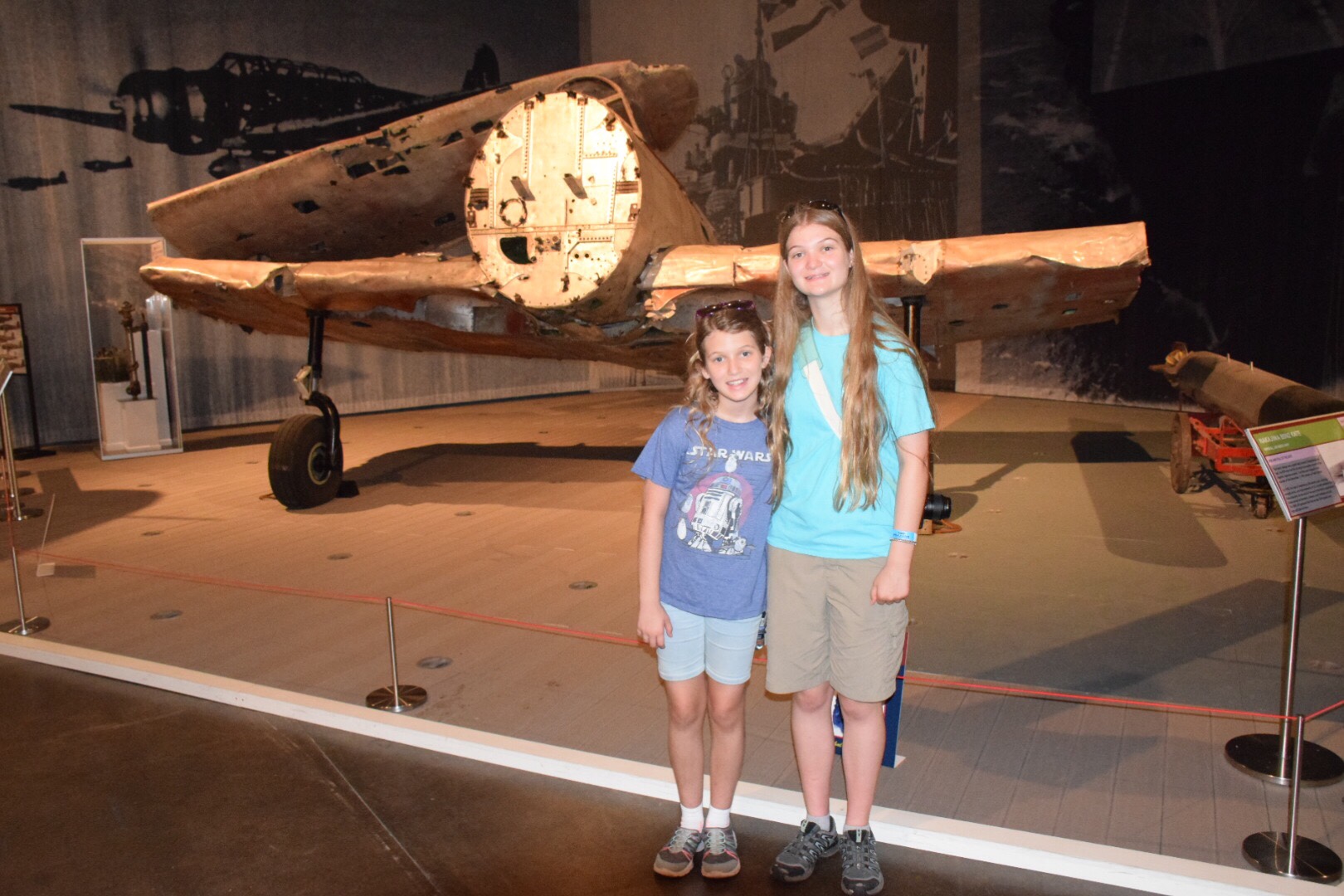
The Kate in this museum is the only one in the U.S. and one of the few remaining in the world.
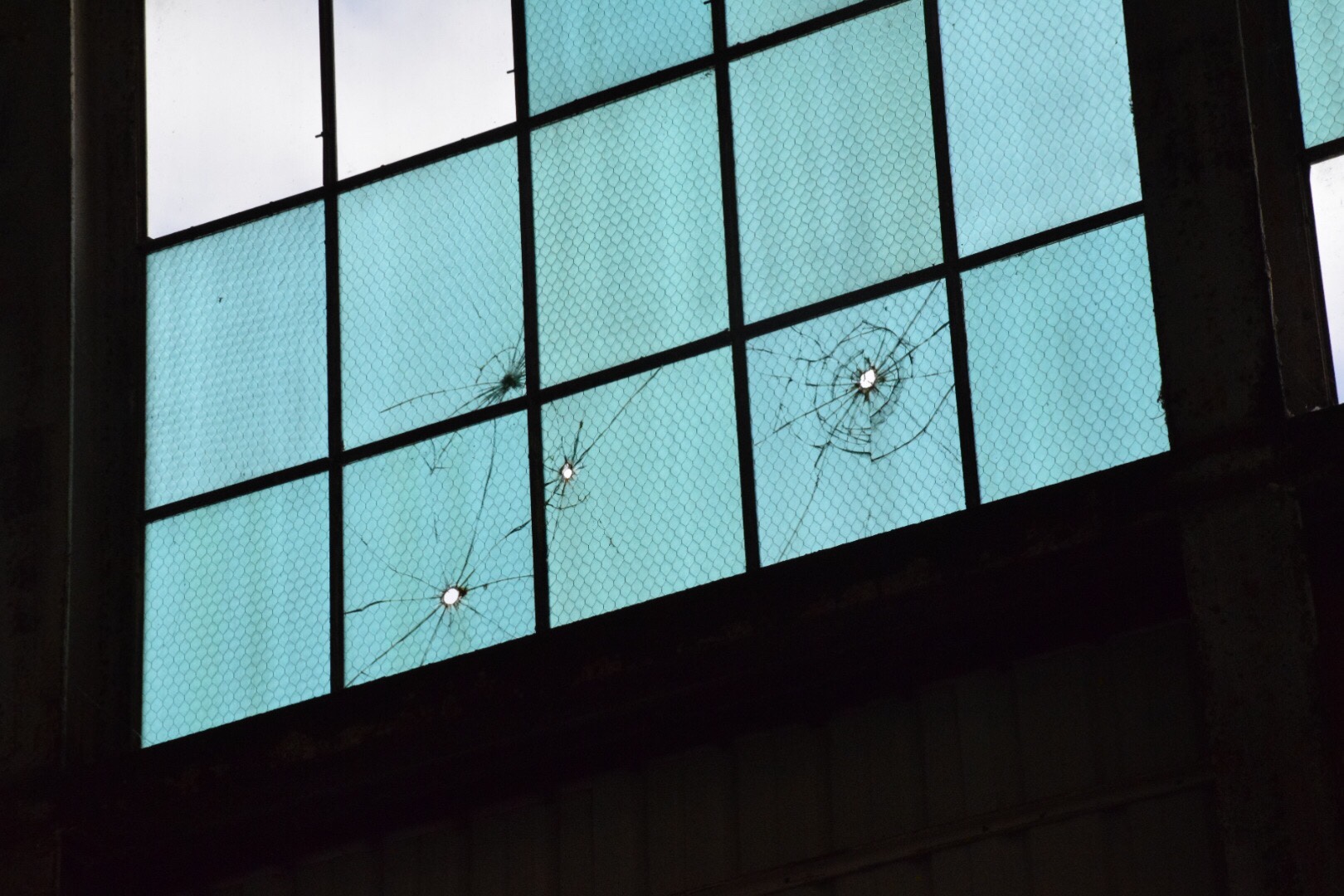
In Hangar 79, you can still see bullet holes in the glass from the Pearl Harbor attack.
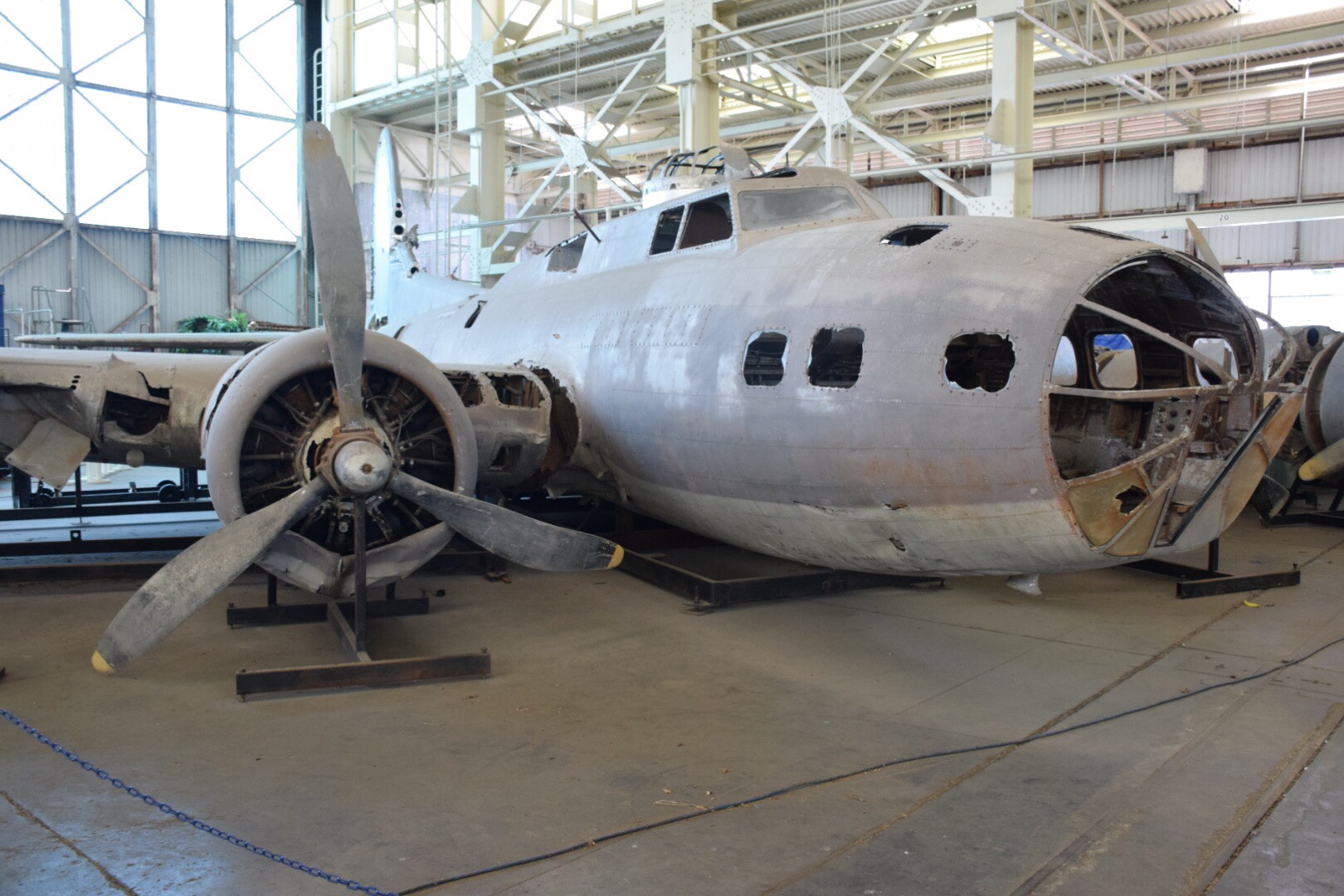
This hangar also contains the “Swamp Ghost,” which is a B-17 Bomber that was recovered from a swamp on a pacific island after having been abandoned for many years.
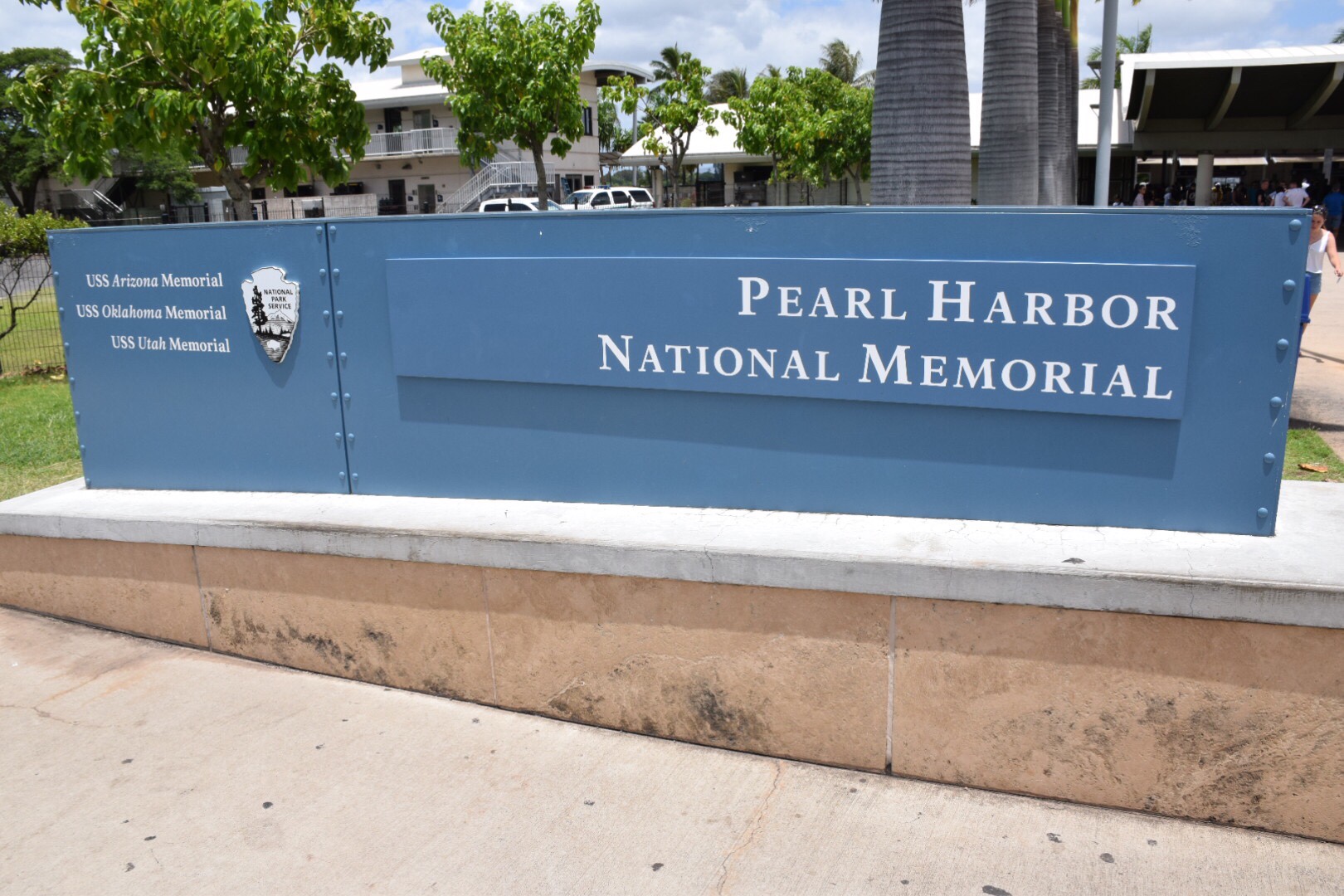
Finally we traveled away from Ford Island and back to the Pearl Harbor National Memorial, which is home to the WWII Valor in the Pacific National Monument and the USS Arizona Memorial. At the Memorial, Kate and Sara completed the Junior Ranger Program and were sworn in by Park Rangers.
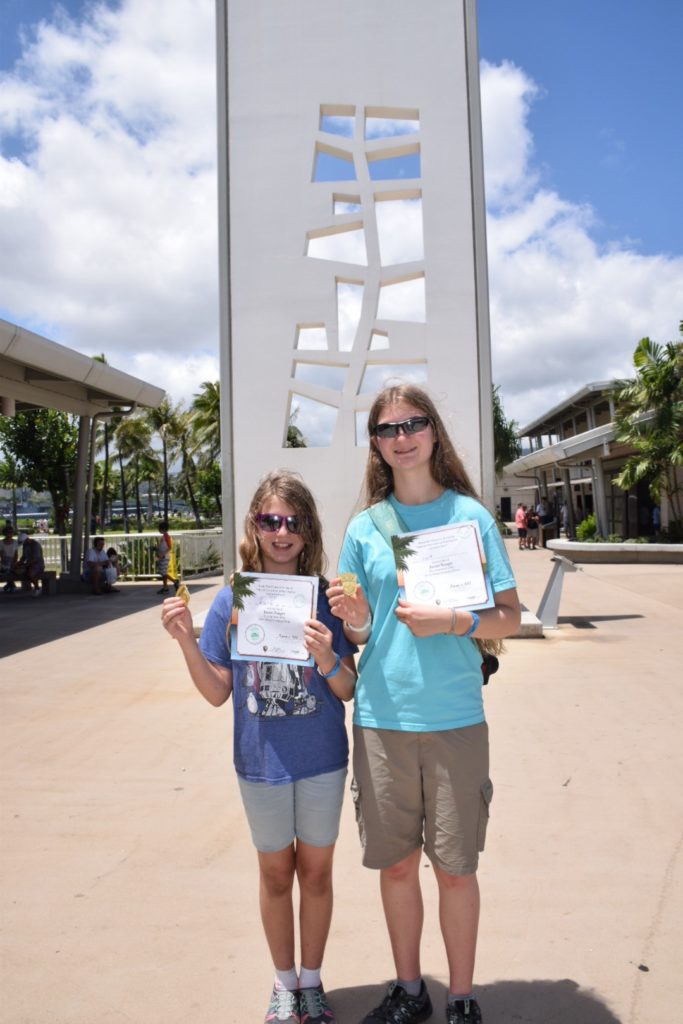
This program consisted of completing a scavenger hunt on the grounds, which was also a source of lots of information about the attack on Pearl Harbor.
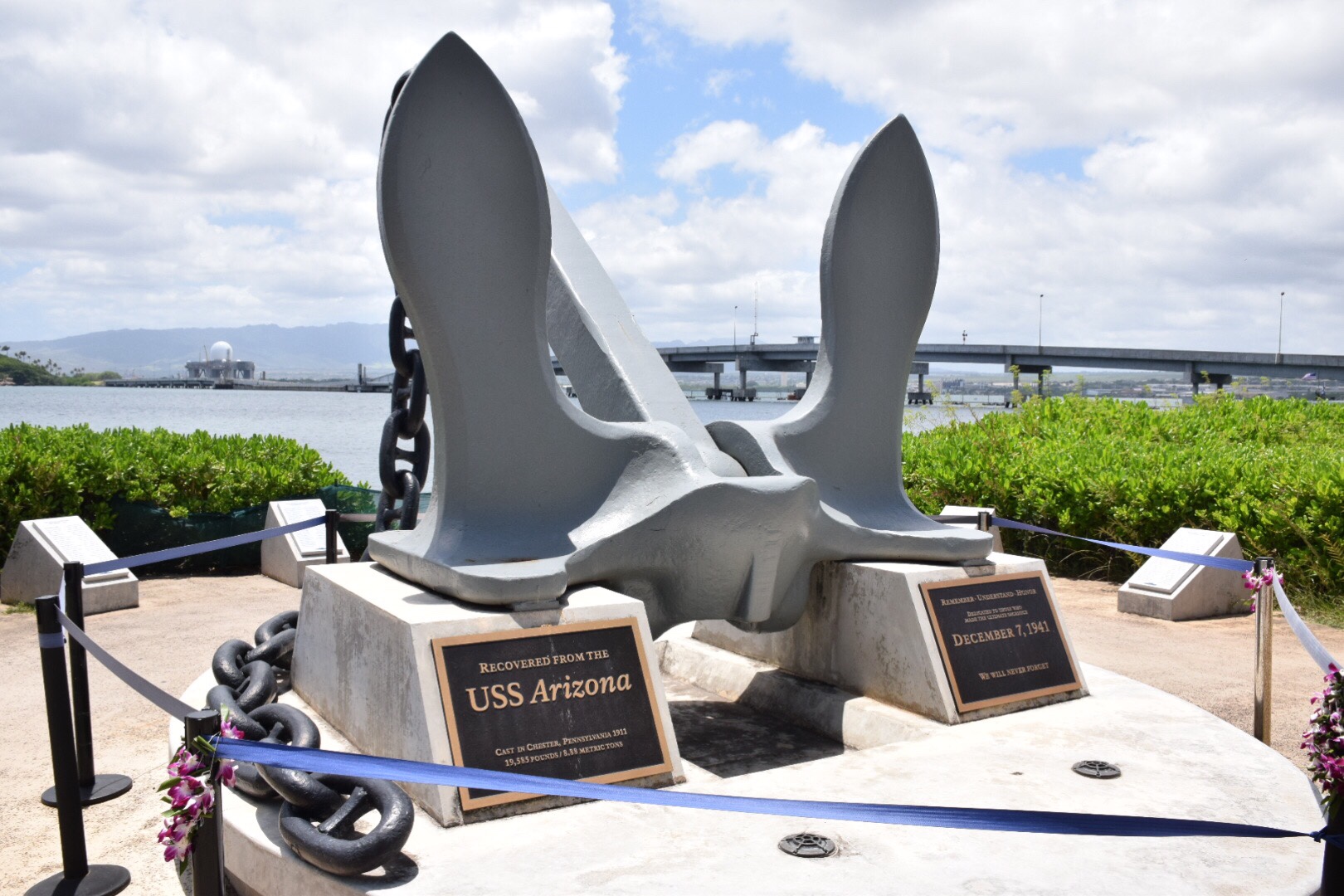
During this scavenger hunt, we toured a couple of small museums and saw a number of artifacts on the grounds such as the bell and anchor from the Arizona, and a replica of the “Tree of Life” that is part of the memorial out on the harbor.

We also learned that the USS Arizona was commissioned in 1916 and that it was a Pennsylvania Class battleship.
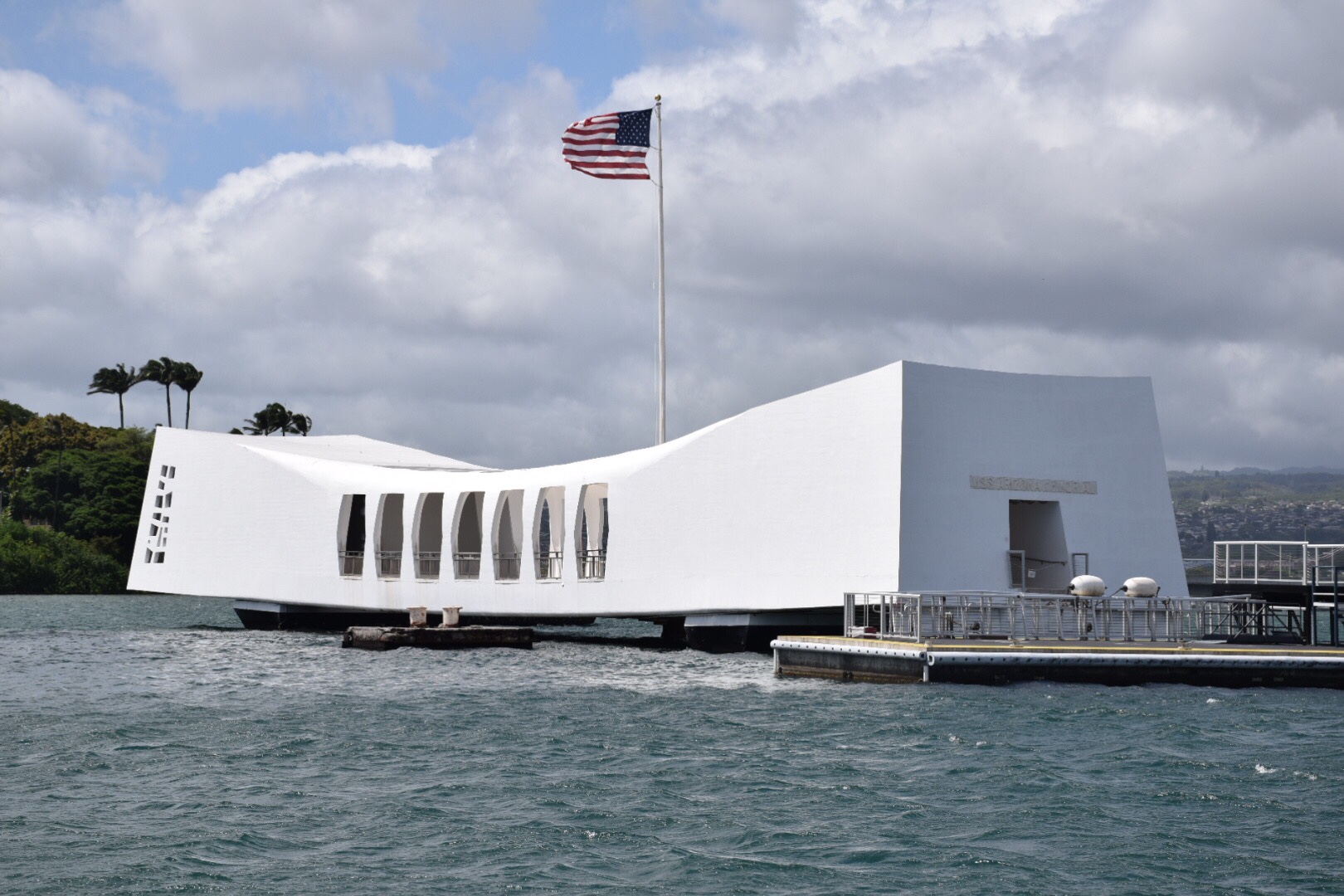
At 2:15pm, we watched a short film about the attack on Pearl Harbor and the USS Arizona Memorial and then boarded a Navy boat for a tour of the harbor. The USS Arizona Memorial is currently closed due to damage to the dock, so all we could do was see the memorial from the boat. During the boat ride we learned that of the 1,177 sailors lost on the ship, 900 remain on Arizona. We learned that the Arizona is 600 feet long and that oil continues to leak from the ship at a rate of one to two gallons per day. There is no way to know how long it will last. The memorial itself is 184 feet long and straddles the Arizona, but does not touch it. The memorial was completed in 1962. Over 40 survivors of the Arizona have had their remains added to the site after their death.
Even though we didn’t get to board the memorial itself, this was still a very moving experience. To know that so many gave their lives for our country and remain buried on the Arizona is humbling.
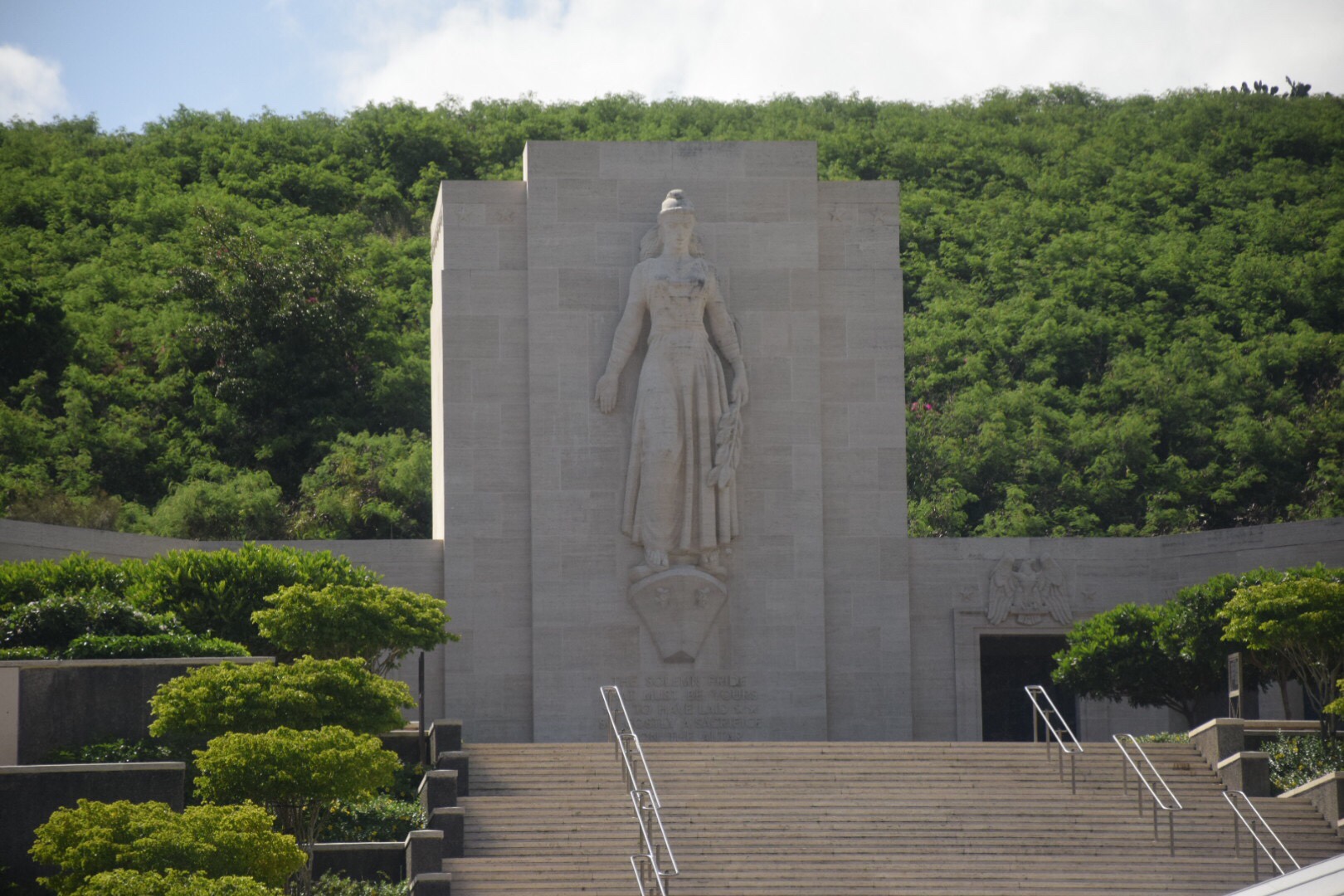
After leaving Pearl Harbor, we stoped at the Punchbowl Crater, which is home to the National Memorial Cemetery of the Pacific. It is located in Honolulu in the town of Punchbowl. This is a military cemetery used for Pacific conflicts. This may sound weird to say about a Cemetery, but the site is beautiful.

Also, the views of Honolulu while going up the the Punchbowl Crater are stunning.
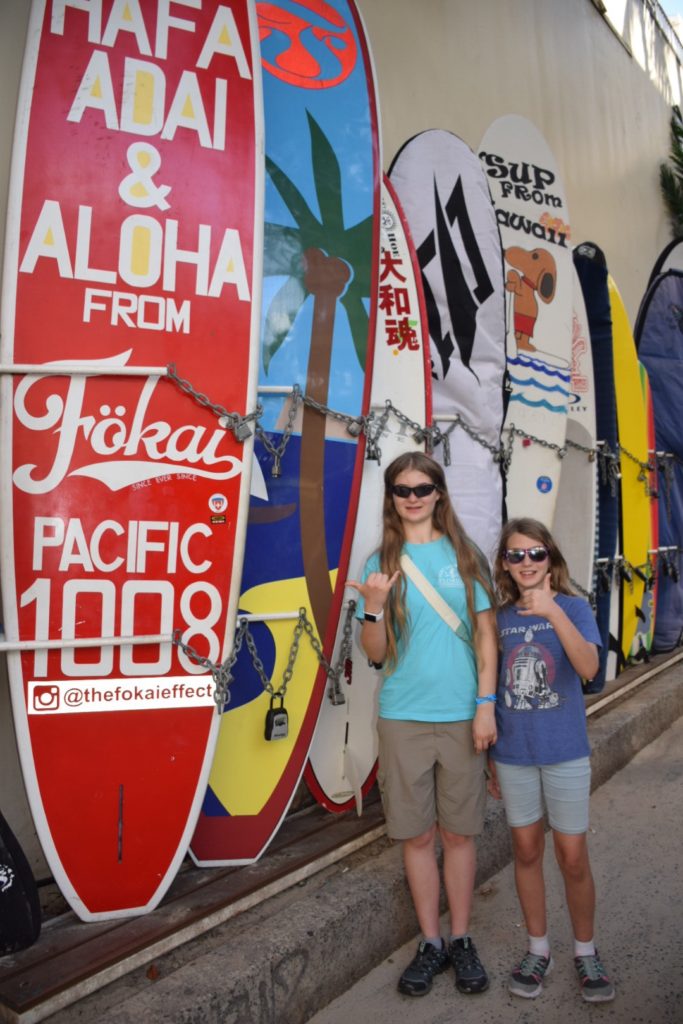
Back at the hotel, we walked around in Waikiki on Kalakaua Avenue, which is kind of like Fifth Avenue in New York. We stopped at listened to some steel guitar music for a bit before continuing onto Duke’s for dinner, right on Waikiki beach.
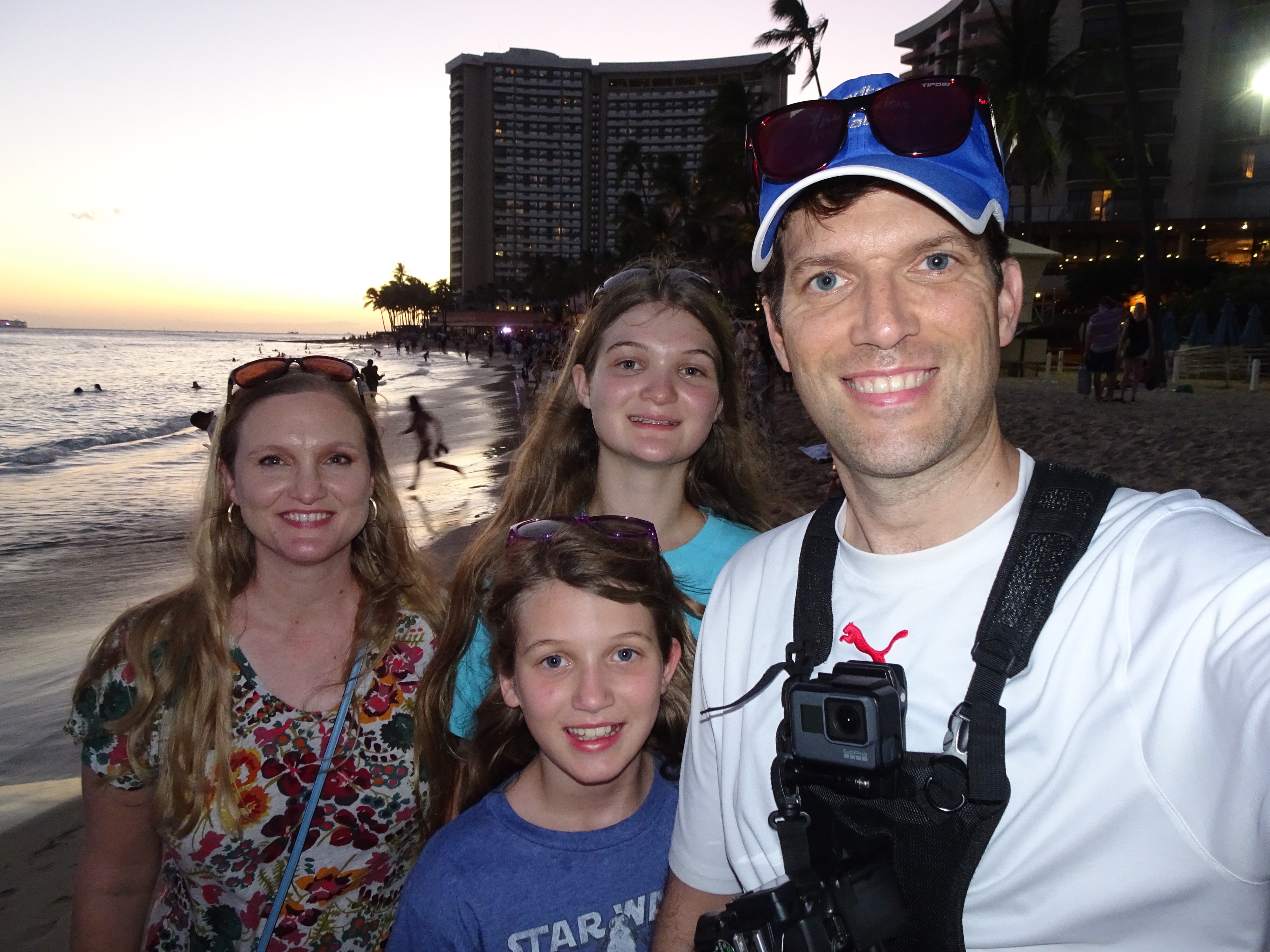
After dinner, we walked down to the beach to watch some surfers, and then went back to the hotel where they had fireworks on the beach after dark.
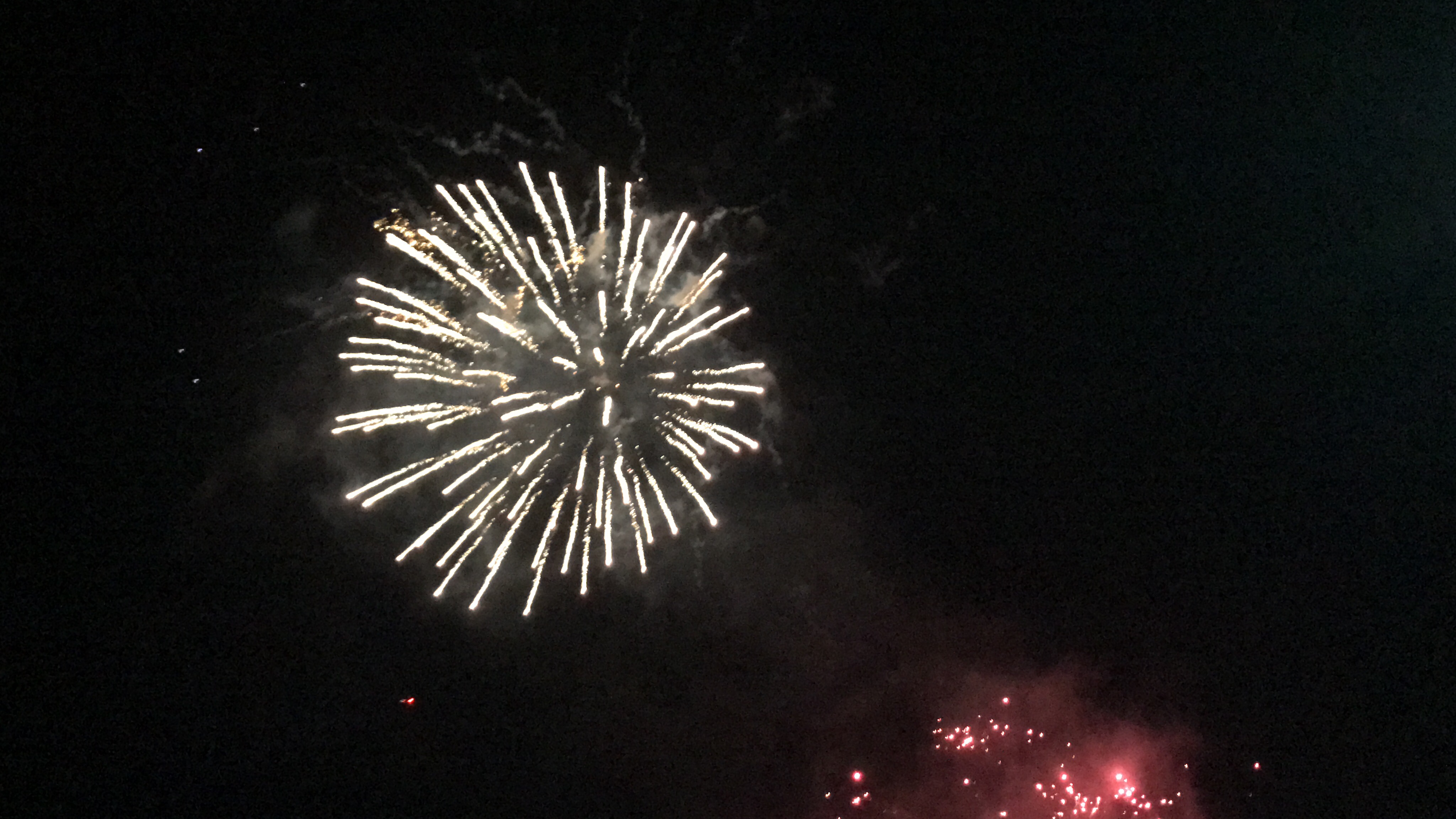
Tomorrow will be our last day in Oahu for a while, and then we will board the NCL Pride of America and head to Maui.
